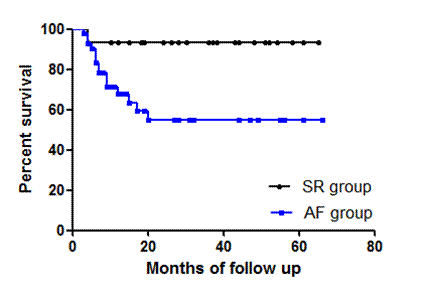| єя«•«ьљƒ : ±Єњђ
|
ЅҐЉцєш»£ - 550354 155 |
| Can the Response to Antiarrhythmic Drugs for the Cardioversion Prior to Catheter Ablation Predict the Long-term Outcome of Catheter Ablation for Persistent Atrial Fibrillation |
| к≥†л†§лМАнХЩкµРл≥СмЫР лґАм†ХлІ•мДЉнД∞ |
| к∞Хм§АнШБ, , кµ≠нШХлПИ, мЭілМАмЭЄ, л∞ХмШИлѓЉ, л∞ШмІАмЭА, мµЬмҐЕмЭЉ, мЮДнЩНмЭШ, л∞ХмГБмЫР, кєАмШБнЫИ |
Aims: Persistent atrial fibrillation(PeAF) can cause atrial and ventricular remodeling, with chamber dilation and dysfunction. Antiarrhythmic drug(AAD) therapy was reported to have an ability to reverse those adverse changes. We investigated whether PeAF patients who had a history of restoring sinus rhythm (SR) by single AADs achieved better outcomes of catheter ablation (CA), compared to those without any positive response to AADs.
Methods: Seventy three patients with PeAF were enrolled. AADs included amiodarone, propafenone and flecainide. A positive response to AADs was defined as conversion to the SR within 1 week after AADs were taken. We divided the patient into 2 groups: the SR group who had the positive response to AADs and the atrial fibrillation(AF) group who did not.
Results: Thirty patients out of the 73 patients (41%) had a positive response to AADs: 11 to amiodarone, 10 to flecainide, and 9 to propafenone. In both groups, left atrial diameter and left ventricular ejection fraction did not change before and after AAD therapy. Kaplan-Meier survival analysis showed that AF group experienced more AF recurrence than SR group (p=0.002). Longer AF duration was also associated with the higher rate of recurrence (p=0.005). Cox regression analysis indicated that non-restoration of SR after AAD therapy and sustained AF for more than 7 months were significant predictors of AF recurrence after CA (odds ratio = 6.456, p=0.014 for the former; odds ratio=2.972, and p=0.022 for the latter).
Conclusions: Restoration of SR after single AAD therapy might be a predictor of favorable long-term outcomes after ablation even without improvement in cardiac function and structural remodeling. Another mechanism besides reverse remodeling might be involved in electrophysiological changes after AAD therapy.
|
|
|
Warning: getimagesize(/home/virtual/circulationadmin/renewal/econgress/conference/abstract/img_files/SRgvsAFgrfig1.gif) [function.getimagesize]: failed to open stream: No such file or directory in /home/virtual/circulationadmin/new/econgress/conference/manage/schedule/view_abstract.php on line 164

|
|





